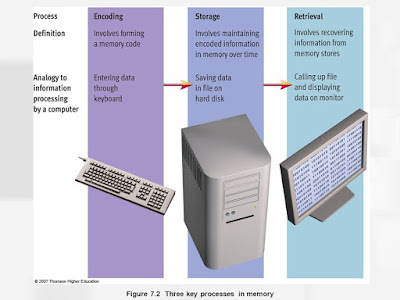BIOLOGICAL BASICS OF BEHAVIOUR
NEURONS
- Neurons are basic working unit of the
brain as it transmits information to the nerve cells, muscle, gland cells.
- Neurons
are specialized to transmit information throughout the body in two ways which
is chemical and electrical.
Structure Of Neurons
·
Axon
-
Carries nerve
impulses away from a cell body of a
neurone.
·
Dendrite
-
Carries nerve impulses
from adjacent neurons into the cell body.
·
Cell body (Soma)
-
Responsible for
maintaining life of the cell as it contains the nucleus.
·
Myelin Sheath
-
Insulates the axon and speeds up the neural
impulse.
Types Of Neurons
·
Sensory Neuron
-
Carry signals from the
outer parts of your body into the central nervous system.
·
Motor Neuron
-
Carry signals from the
central nervous system to the outer parts of your body.
·
Interneuron
-
Connect various
neurons within the brain and spinal
cord.
GLIAL CELLS
·
Glial cells are the
most abundant cell types in the central nervous system.
·
The functions of the glial cells are:
-
They surround neurons and
hold them in place.
-
They supply nutrients
and oxygen to the neurons.
-
Insulates one neuron
from another.
-
They destroy and
remove dead neurons.
THE NEURAL IMPULSE
·
An electrical signal
that travels along an axon. There is an electrical difference between the
inside of the axon and its surroundings, like a tiny battery
The Synapse
Transmission Between Neurons
- Synaptic
vesicles
-
Sacs in terminal
button that release chemical into synaptic space.
·
Neurotransmitters
-
Communication between
neurons as accomplished by the movement of chemical or electrical signals
across synapse.
·
Receptor sites
- Location on receptor neuron for specific neurotransmitter.
Neural
Plasticity
·
The brain can be
changed, both structurally and chemically by experience.
NERVOUS SYSTEM
·
Nervous system is the
network of nervous cells and fibers that transmits nerve impulse between the
parts of the body.
NERVOUS SYSTEM ORGANISATION
CENTRAL NERVOUS SYSTEM
THE BRAIN- THE CENTRAL CORE
·
Medulla
-
Controls breathing,
heart rate, and blood pressure.
·
Cerebellum
-
Coordinates body’s
movements.
·
Pons
-
Maintains the sleep
wake cycle.
·
Thalamus
-
Involved in sensory
and motor signal relay and the regulations of consciousness and sleep.
·
Hypothalamus
-
It plays an important
role in hormone production and helps to stimulate many important processes in
the body.
-
Involved in emotional
behaviour.
·
Reticular formation
-
Monitors the state of
the body and functions inn such processes s arousal, sleep, attention and
muscle tone.
THE BRAIN- THE LIMBIC SYSTEM
·
The limbic system is a
grouping of structures in the brain that sits between in the most primitive
part of the forebrain called the rhinecephalon. This is a doughnut-shaped
network of neurons that inlfuences many deep-rooted drives and emotions
including pain, anger, hunger, sex, thirst, and pleasure.
·
The thalamus,
hypothalamus, amygdala, fornix, mammiliary bodies, and septal areas are all
parts of the limbic system.
THE
CEREBRAL CORTEX
·
Is the largest part of the human brain,
associated with higher brain function such as thought and action.
·
The cerebral cortex is
divided into four sections, called "lobes": the frontal lobe,
parietal lobe, occipital lobe, and temporal lobe.
HEMISPHERIC
SPECIALISATION
·
The brain has two
halves or hemispheres which right and
left hemispheres.
·
Each hemisphere appears to specialise in
certain functions.
TOOLS FOR STUDYING THE NERVOUS SYSTEM
·
Microelectrode
Technique
-
Very small electrodes
inserted into individual neurons.
-
Used to study activity
of a single neuron.
·
Macroelectrode
Technique
-
Used to get a picture
of overall activity in the brain.
-
For example, an EEG
which uses electrodes placed on a persons’s scalp to measure brain activity.
·
Structural Imaging
1)
Computerized Axial
Tomography (CT- SCAN)
-
Uses X-rays to create
a 3-dimensional image of the brain.
2)
Magnetic Resonance
Imaging (MRI)
-
Uses a magnetic field
and radio waves to produce images.
·
Functional Imaging
1)
EEG Imaging
-
Electrical activity on
the scalp from millions neurons is to
produce a continuous picture of activity in the brain.
2)
Magentoencephalography
(MEG) and Magnetic Source Imaging (MSI)
-
Can localize activity more precisely than
EEG.
3)
Positron Emission
Tomography (PET) and Single Photon Emission Computed Tomography ( SPECT)
-
Use radioactive
glucose to determine location of greatest brain activity.
·
Functional Mangnetic
Resonance Imaging (fMRI)
-
Shows functions and
structure by measuring movement of blood molecules within the brain.
THE SPINAL CORD
·
The cord of nerve
tissue extending through the spinal canal of the spinal column.
·
The spinal cord
carries information from extremities and internal organs to the brain.
REFLEX ACTIONS CONTROLLED BY SPINAL
CORD
THE PERIPHERAL NERVOUS SYSTEM
THE ENDOCRINE SYSTEM
·
Is made up of glands
that produce and secrete hormones, chemical substances produced in the body
that regulate the activity of cells or organs.
·
Hormones produced by
the endocrine system regulates the body’s growth, metabolism, and sexual
development.
GENES, EVOLUTION AND BEHAVIOR
Genetics
·
The heredity and the
variation of inherited characteristics.
1) Chromosomes
-
Pairs of thread like
bodies that contain genes.
2) Deoxyribonucleic
Acid
-
Ideal molecules to
transfer genetic messages to every cell of our body.
BEHAVIOR GENETICS
·
Study of behaviour
from a genetic perspective.
HUMAN BEHAVIOR
GENETICS
·
Family studies
-
Assume that close
family members share more of a trait than non-relatives.
-
Used to assess the
heritability of psychological disorders or traits than non-relatives.
·
Twin studies
-
Used to determine how
heritable a trait or disorder may be.
-
Identical twins would
have highest heritability.
·
Adoption studies
-
Used to assess the
influence of environment.
·
Molecular genetics
-
Direct study of the
genetic code.
EVOLUTIONARY
PSYCHOLOGY
·
Evolutionary
psychology looks at the adaptive or survival of behaviors.
SOCIAL IMPLICATIONS
·
Study of how people’s
thoughts, feelings, and behaviors are influenced by the actual, imagined, or
implied presence of others.
videos for further referrences:






















Comments
Post a Comment